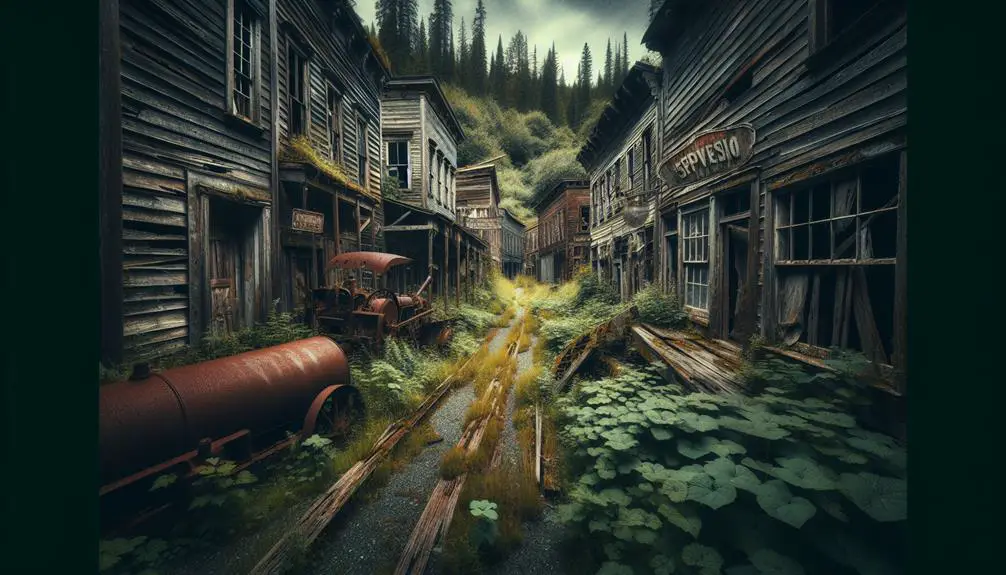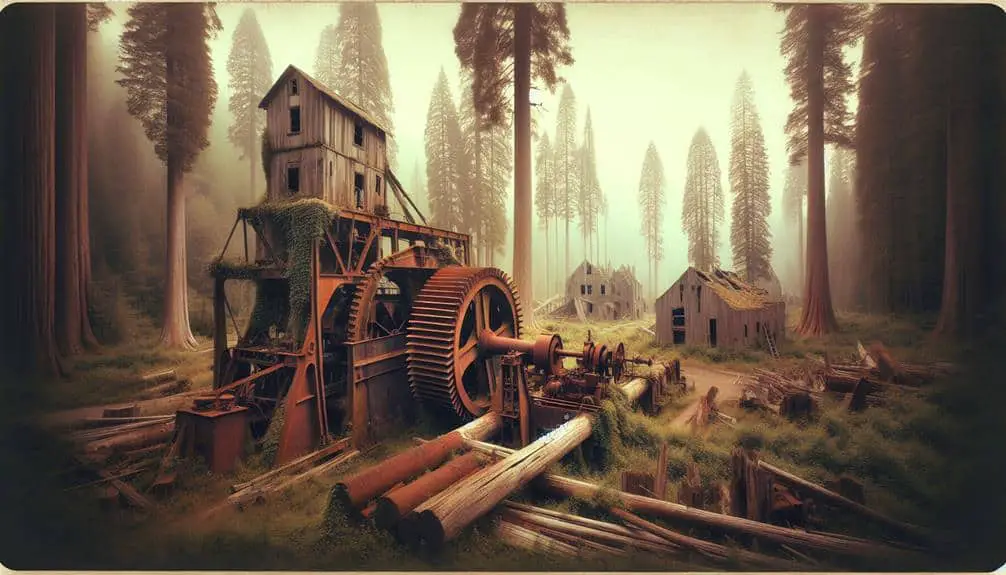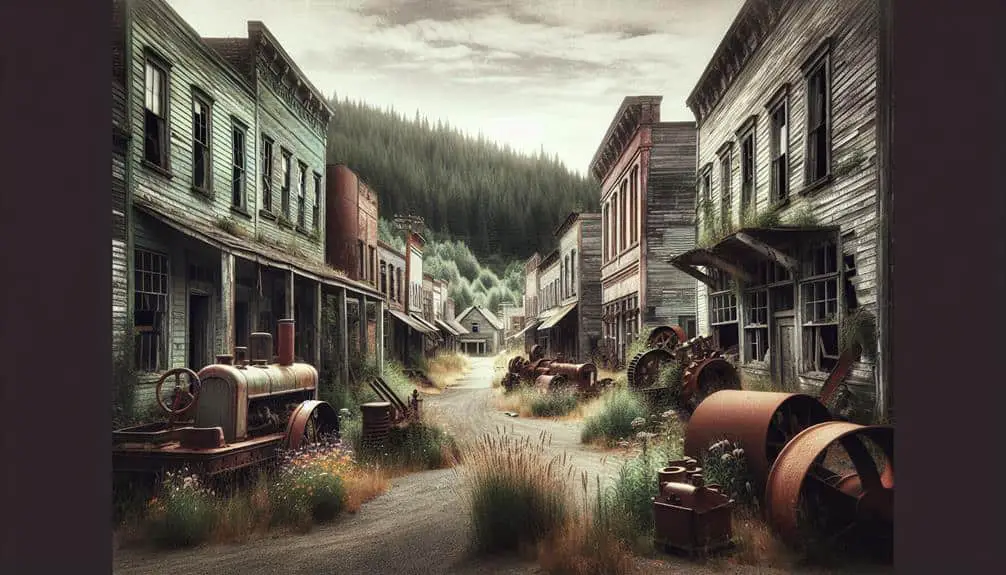Step back in time as you explore the eerie remnants of abandoned logging towns in America. Hear the whispers of a bustling past amidst decaying structures and overgrown landscapes. Witness the industrial decline and rusted machinery that once fueled a nation's thirst for timber. These ghost towns offer a poignant glimpse into the bygone era of American history. As you uncover more about their haunting history, you'll gain a deeper appreciation for the impact of logging activities on both the economy and the environment.
Key Points
- Explore Centralia in Pennsylvania, abandoned due to a coal mine fire.
- Visit Lester in Washington, a once thriving logging town.
- Engage in urban exploration in deserted areas.
- Experience America's rich history through abandoned towns.
- Witness remnants of a bygone era in American logging history.
History of Logging Towns in America
Indisputably intertwined with the expansion of the American frontier, the history of logging towns in America is a demonstration of the relentless pursuit of natural resources and the communities that flourished and faded in its wake. These towns emerged as crucial hubs driven by the demand for lumber during the nation's growth. However, the prosperity of these logging towns was often short-lived, marked by a cycle of economic boom and subsequent decline.
The economic decline of logging towns stemmed from the exhaustion of timber resources in the surrounding areas. As the once-abundant forests were depleted, logging operations became economically unviable, leading to widespread unemployment and a mass exodus of residents. This decline not only impacted the local economy but also reverberated through the entire community, causing social upheaval and a loss of identity.
Moreover, the environmental impact of logging activities played a significant role in the decline of these towns. Deforestation, soil erosion, and water pollution were common consequences of unchecked logging practices, leaving behind degraded landscapes that further hindered economic recovery. The legacy of these logging towns serves as a cautionary tale, highlighting the delicate balance between economic development and environmental preservation.
Factors Leading to Abandonment
The demise of these once-thriving logging towns can be attributed to a convergence of interconnected factors that ultimately led to their abandonment.
- Economic Decline: The logging industry faced economic downturns, with decreased demand for timber products and increased competition from modern logging practices. This economic instability made it challenging for logging towns to sustain themselves financially.
- Environmental Impact: Unregulated logging practices led to deforestation, soil erosion, and water pollution, resulting in environmental degradation. As natural resources dwindled, the ecosystem could no longer support the logging towns, forcing residents to seek livelihoods elsewhere.
- Shift in Industry Dynamics: Advances in technology and transportation made it more cost-effective to harvest timber from larger forests, rendering the smaller logging towns obsolete. This shift in industry dynamics left many logging towns struggling to adapt and compete in a rapidly changing market.
These factors, coupled with a lack of diversification in the local economy, contributed to the abandonment of once-vibrant logging communities across America.
Haunting Remnants of Logging Industry
Amidst the silent remnants of the logging industry, echoes of a bygone era linger in the desolate landscapes of abandoned logging towns. The logging industry, once a bustling hub of activity, now stands as a ghostly reminder of its environmental impact. The towering trees that once dominated the skyline have been replaced by empty lots and decaying structures, a stark contrast to the vibrant ecosystem that once thrived.
Industrial decline has left these towns in a state of disrepair, with rusted machinery and forgotten tools scattered among the overgrown vegetation. The logging camps that were once filled with the sounds of saws and shouts of workers now echo only with the whispers of the wind.
Community displacement further adds to the haunting atmosphere, as the homes and businesses that once housed families and livelihoods now stand empty and abandoned. The sense of loss and nostalgia is palpable, as these towns serve as a poignant reminder of the fleeting nature of industry and progress.
Preservation Efforts for Ghost Towns
As efforts to preserve these abandoned logging towns gain momentum, a renewed focus is placed on safeguarding their historical significance and cultural heritage. Preservation initiatives are cropping up across the country, aiming to make certain that these ghost towns aren't forgotten but instead revitalized and celebrated. Community involvement plays a pivotal role in these efforts, with local residents and volunteers coming together to breathe new life into these once-thriving settlements.
- Historic Building Restoration: Dilapidated structures are carefully restored to their former glory, preserving the architectural charm and history of the town for future generations to appreciate.
- Cultural Events and Festivals: Vibrant events and festivals are organized within these ghost towns, allowing visitors to immerse themselves in the rich heritage and traditions that once thrived in these communities.
- Educational Programs: Schools, museums, and guided tours are established to educate the public about the logging industry's impact on these towns, fostering a deeper appreciation for their significance.
Must-Visit Abandoned Logging Towns
Discover these abandoned logging towns that offer a fascinating glimpse into America's rich history and forestry past. Embark on a journey of urban exploration to uncover the hidden stories of forgotten communities that once thrived in these now deserted areas.
One must-visit abandoned logging town is Centralia in Pennsylvania. This ghost town was abandoned due to a coal mine fire that has been burning underground since 1962, creating an eerie landscape of cracked roads and smoke rising from fissures in the ground. The town serves as a haunting reminder of the impact of industrialization on local communities.
Another intriguing destination is the town of Lester in Washington. This logging town was once a bustling hub of activity, but now lies in ruins, with decaying buildings and rusted machinery scattered throughout the area. Exploring Lester allows you to witness firsthand the remnants of a bygone era in American history.
Frequently Asked Questions
How Did the Logging Industry Impact the Local Ecosystems and Wildlife in These Abandoned Towns?
When logging altered the landscape, ecosystems suffered, leading to disrupted habitats for local wildlife. Conservationists now work diligently to restore balance by implementing sustainable logging practices and focusing on ecosystem restoration to mitigate wildlife impact.
What Were the Living Conditions Like for the Workers and Families in These Logging Towns?
You navigated through the rough waters of living conditions in those forgotten towns. Crowded shacks housed hopes and sorrows, creating a tapestry of resilience and strife. Community dynamics wove stories of survival amidst the towering trees.
Are There Any Legends or Ghost Stories Associated With the Abandoned Logging Towns?
You might be curious about the abandoned logging towns' eerie past. Ghost stories, legends, and mysterious happenings swirl around these forgotten places. Folklore tells of paranormal activity and supernatural occurrences that add to their mystique.
How Do Historians and Archaeologists Uncover the History of These Forgotten Towns?
To uncover the history of forgotten towns, historians and archaeologists meticulously sift through layers of time. They excavate sites, analyze historical artifacts, and piece together narratives from the past, shedding light on the stories of bygone eras.
What Challenges Do Preservationists Face in Maintaining and Protecting These Abandoned Logging Towns?
Preservation challenges for abandoned logging towns are complex. Environmental impact poses hurdles in maintaining structures. Balancing historical integrity with nature's reclamation is tough. Protecting these sites requires innovation and dedication from preservationists.



